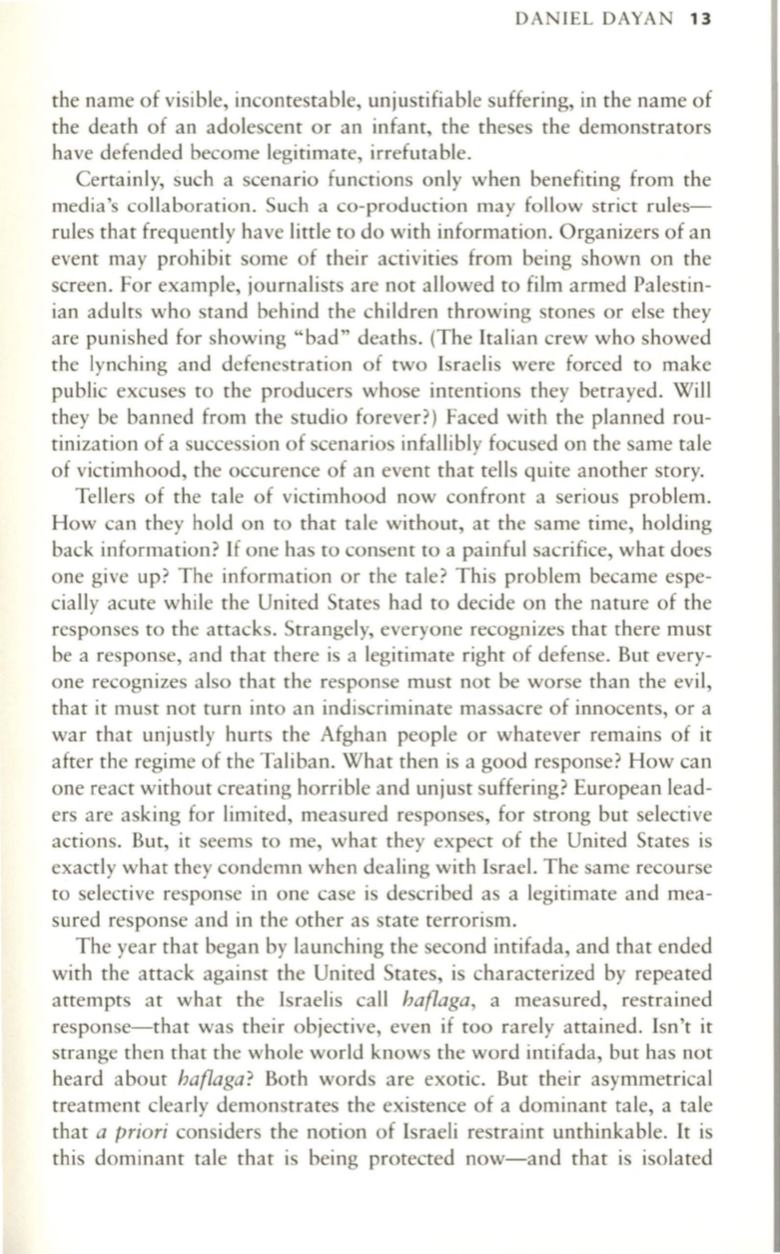
DANIEL DAYAN 13
the name of visible, incontestable, unjustifiable suffering, in the name of
the death of an adolescent or an infant, the theses the demonstrators
have defended become legitimate, irrefutable.
Certainly, such a scenario functions only when benefiting from the
media's collaboration. Such a co-production may follow strict rules–
rules that frequently have little to do with information. Organizers of an
event may prohibit some of their activities from being shown on the
screen. For example, journalists are not allowed to film armed Palestin–
ian adults who stand behind the children throwing stones or else they
are punished for showing "bad" deaths. (The Italian crew who showed
the lynching and defenestration of two Israelis were forced to make
public excuses to the producers whose intentions they betrayed. Will
they be banned from the studio forever?) Faced with the planned rou–
tinization of a succession of scenarios infallibly focused on the same tale
of victimhood, the occurence of an event that tells quite another story.
Tellers of the tale of victimhood now confront a serious problem.
How can they hold on to that tale without, at the same time, holding
back information?
If
one has to consent to a painful sacrifice, what does
one give up? The information or the tale? This problem became espe–
cially acute while the United States had to decide on the nature of the
responses to the attacks. Strangely, everyone recognizes that there must
be a response, and that there is a legitimate right of defense. But every–
one recognizes also that the response must not be worse than the evil,
that it must not turn into an indiscriminate massacre of innocents, or a
war that unjustly hurts the Afghan people or whatever remains of it
after the regime of the Taliban. What then is a good response? How can
one react without creating horrible and unjust suffering? European lead–
ers are asking for limited, measured responses, for strong but selective
actions. But, it seems to me, what they expect of the United States is
exactly what they condemn when dealing with Israel. The same recourse
to selective response in one case is described as a legitimate and mea–
sured response and in the other as state terrorism.
The year that began by launching the second intifada, and that ended
with the attack against the United States, is characterized by repeated
attempts at what the Israelis call
haflaga,
a measured, restrained
response-that was their objective, even if too rarely attained. Isn't it
strange then that the whole world knows the word intifada, but has not
heard about
haflaga?
Both words are exotic. But their asymmetrical
treatment clearly demonstrates the existence of a dominant tale, a tale
that
a priori
considers the notion of Israeli restraint unthinkable. It is
this dominant tale that is being protected now-and that is isolated


